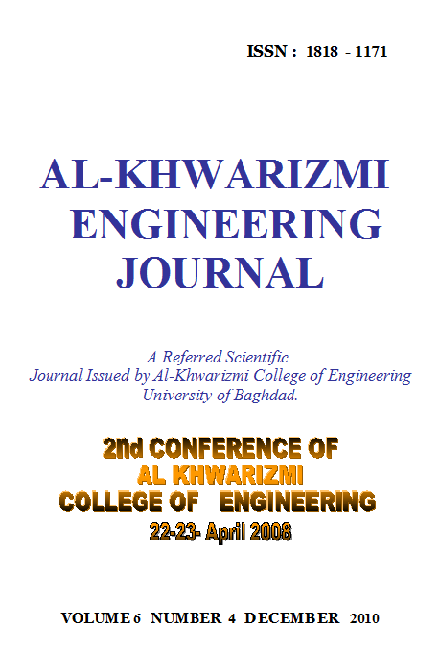الامتصاص الحيوي لايونات الكروم سداسية التكافؤ من المحلول المائي بأستخدام الياف نخيل التمر
الملخص
ركزت الدراسة الحالية على قدرة الياف نخيل التمر في ازالة ايونات الكروم سداسية التكافؤ Cr (VI) من المحلول المائي. تضمنت الدراسة تأثير الدالة الحامضية , زمن التعرض , تركيز المادة النباتية الممتزة اضافة الى التركيز الاولي لايون الكروم سداسي التكافؤ Cr (VI) على قابلية الياف النخيل في ازالة هذه الايونات من المحلول المائي .تم قياس تركيز ايون الكروم المتبقي في المحلول لونيا باستخدام جهاز المطياف عند طول موجي 540 نانو ميتر.
اعتمدت عملية الازالة على تركيز ايون الهيدروجين في المحلول حيث وجد ان الدالة الحامضية المثلى التي اعطت اعلى نسبة ازالة لايون الكروم سداسي التكافؤ كانت 7 وتوافقت معادلة التكافؤ الحراري مع معادلة Langmuir وكانت بالشكل Ce/Cs = 79.99Ce-77.39 في حين ان معامل الارتباط بلغ0.908, من نتائج الدراسةوجد ان كفاءة الياف نخيل التمر في ازالة عنصر الكروم من المحلول كانت عالية بلغت98.6 % عند زمن الاتزانEquilibrium time .
التنزيلات
المراجع
[2] Ahalya, N., Ramachandra, T.V.and Kanamadi, R.D., (2004): Biosorption of heavy metals, Western Ghats Aquatic biodiversity, Sahyadri E news, issu5.
http://wgbis.ces.iisc.ernet.in/biodivercity/newsletter/issue5/index.htm
[3] Jabir, B., A., (2006): Biosorption of dissolved Pb (II) in dilute aqueous solution by using agro – waste products. Msc. Theses, college of engineering / Baghdad University.
[4] Jonglertjunya, W. (2008): biosorption of lead (II) and copper (II) from aqueous solution .Chiang MaiJ.Sci.35 (1):69-81.
[5] Babarinde, A., Babalola, J.O., and Sanni, S.O., (2007): Isotherm and thermodynamic studies of the biosorption of Cd (II) from solution by maize leaf .Intern. Jor. phy. Sci 2(8):207-211.
[6] Babarinde, A., Babalola, J.O., and Olkanni, O. (2008): Thermodynamic and isotherm studies of the biosorption of Cd (II) from solution by maize wrapper. Intern. Jor.phy.Sci 3(3):71-74.
[7] Vankar, P., Bajpai, D. (2008): Phyto-remediation of chrome (VI) of tannery effluent Trichoderma species .Desalination 222,255-262.
[8] Abawy, S.A., Hassan, M.S. (1990): Practical Environmental Engineering, tests of water, Dar AL-Hekma, Iraq.
[9] Lui, Y., Chang, X., Gue, Y. and Meng, S. (2006): Biosorption and preconcentration of lead and cadmium on waste Chinese herb .Pang DA Hai. J. Hazard.Mater. B135:389-394.
[10] Pavasant, P. Apiratikul, R. Sungkhum, V. Suthiparinyanont, P. and Marhaba, T.(2006): Biosorption of Cu(II), Cd(II), Pb(II) and Zn(II) using dried marine green macro algae Caulerpa lentilifera. Bioresour Technol.97:2321-2329.
[11] Watts, R.J., (1998): Hazardous Wastes: Sources, Pathways, Receptors. John Wiely & Sons. INC.
منشور
إصدار
القسم
الرخصة
حقوق الطبع والنشر: يحتفظ مؤلفو الوصول المفتوح بحقوق الطبع والنشر لاعمالهم، ويتم توزيع جميع مقالات الوصول المفتوح بموجب شروط ترخيص Creative Commons Attribution License، والتي تسمح بالاستخدام غير المقيد والتوزيع والاستنساخ في أي وسيط، بشرط ذكر العمل الأصلي بشكل صحيح. إن استخدام الأسماء الوصفیة العامة، والأسماء التجاریة، والعلامات التجاریة، وما إلی ذلك في ھذا المنشور، حتی وإن لم یتم تحدیدھ بشکل محدد، لا یعني أن ھذه الأسماء غیر محمیة بموجب القوانین واللوائح ذات الصلة. في حين يعتقد أن المشورة والمعلومات في هذه المجلة صحيحة ودقيقة في تاريخ صحتها، لا يمكن للمؤلفين والمحررين ولا الناشر قبول أي مسؤولية قانونية عن أي أخطاء أو سهو قد يتم. لا يقدم الناشر أي ضمان، صريح أو ضمني، فيما يتعلق بالمواد الواردة في هذه الوثيقة.











